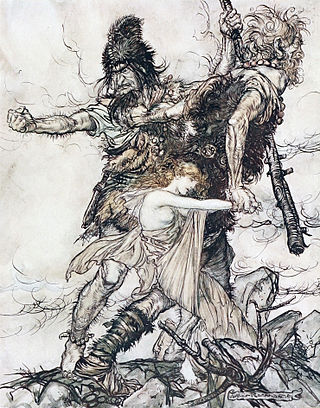
In folklore, giants are beings of humanoid appearance, but are at times prodigious in size and strength or bear an otherwise notable appearance. The word giant is first attested in 1297 from Robert of Gloucester's chronicle. It is derived from the Gigantes of Greek mythology.
A boggart is a supernatural being from English folklore. The dialectologist Elizabeth Wright described it as 'a generic name for an apparition'; folklorist Simon Young defines it as 'any ambivalent or evil solitary supernatural spirit'. Halifax folklorist Kai Roberts states that boggart ‘might have been used to refer to anything from a hilltop hobgoblin to a household faerie, from a headless apparition to a proto-typical poltergeist’. As these wide definitions suggest boggarts are to be found both within and out of doors, as a household spirit or a malevolent genius loci inhabiting fields or other topographical features.
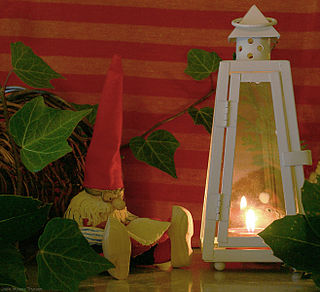
A nisse, tomte, tomtenisse, or tonttu is a mythological creature from Nordic folklore today typically associated with the winter solstice and the Christmas season. They are generally described as being short, having a long white beard, and wearing a conical or knit cap in gray, red or some other bright colour. They often have an appearance somewhat similar to that of a garden gnome.
Hiisi is a term in Finnic mythologies, originally denoting sacred localities and later on various types of mythological entities.

English folklore consists of the myths and legends of England, including the English region's mythical creatures, traditional recipes, urban legends, proverbs, superstitions, and folktales. Its cultural history is rooted in Celtic, Christian, Nordic and Germanic folklore.
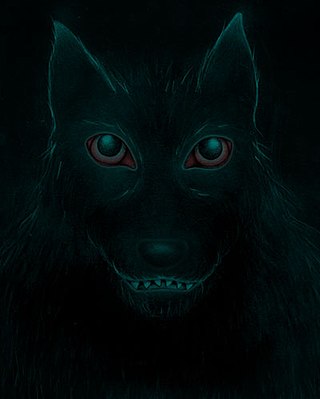
In English folklore, Black Shuck, Old Shuck, Old Shock or simply Shuck is the name given to a ghostly black dog which is said to roam the coastline and countryside of East Anglia, one of many such black dogs recorded in folklore across the British Isles. Accounts of Black Shuck form part of the folklore of Norfolk, Suffolk, the Cambridgeshire Fens and Essex, and descriptions of the creature's appearance and nature vary considerably; it is sometimes recorded as an omen of death, but, in other instances, is described as companionable.

Ujae Atoll is a coral atoll of 15 islands in the Pacific Ocean, and forms a legislative district of the Ralik Chain of the Marshall Islands. Its total land area is only 1.86 square kilometers (0.72 sq mi), but it encloses a lagoon of 185.94 square kilometers (71.79 sq mi). It is located about 122 kilometers (76 mi) west of Kwajalein Atoll.

Folk plays such as Hoodening, Guising, Mummers Play and Soul Caking are generally verse sketches performed in countryside pubs in European countries, private houses or the open air, at set times of the year such as the Winter or Summer solstices or Christmas and New Year. Many have long traditions, although they are frequently updated to retain their relevance for contemporary audiences.
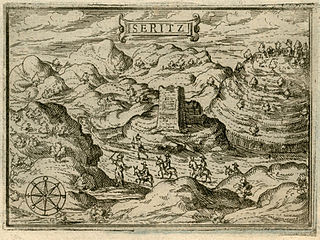
Saris was a Palestinian Arab village that was depopulated during the major offensive launched by the Haganah on 16 April 1948. Called Operation Nachshon, and launched before the British had left Palestine, its objective was to capture villages between Jerusalem and the coastal plain, in order to break to siege of the Jews of Jerusalem.
Coblynau are mythical gnome-like creatures that are said to haunt the mines and quarries of Wales and areas of Welsh settlement in America.
Scottish folklore encompasses the folklore of the Scottish people from their earliest records until today. Folklorists, both academic and amateur, have published a variety of works focused specifically on the area over the years. Some creatures of Scottish folklore are Loch Ness Monster, brownies, bogles, kelpies, selkies, the wulver, the bean-nighe, and the blue men of the Minch.
Peg Powler is a hag and water spirit in English folklore who inhabits the River Tees. Similar to the Grindylow, Jenny Greenteeth, and Nelly Longarms, she drags children into the water if they get too close to the edge. She is regarded as a bogeyman figure who is invoked by parents to frighten children into proper behavior. The 19th century folklorist William Henderson describes Peg Powler as having green hair and "an insatiable desire for human life" and she is said to lure people into the river to drown or be devoured. The foam or froth which is often seen floating on certain parts of the Tees is called "Peg Powler's suds" or "Peg Powler's cream".

The black dog is a supernatural, spectral, or demonic hellhound originating from English folklore that has also been seen throughout Europe and the Americas. It is usually unnaturally large with glowing red or yellow eyes, is often connected with the Devil, and is sometimes an omen of death. It is sometimes associated with electrical storms, and also with crossroads, barrows, places of execution and ancient pathways.

The Koreng, also spelled Goreng, are an indigenous Noongar people of south-west of Western Australia.

The Ararat Plain, called Iğdır Plain in Turkey, is one of the largest plains of the Armenian Highlands. It stretches west of the Sevan basin, at the foothills of the Gegham mountains. In the north, the plain borders on Mount Aragats, and Mount Ararat in the south.
In Scottish folklore the Ghillie Dhu or Gille Dubh was a solitary male fairy. He was kindly and reticent, yet sometimes wild in character. He had a gentle devotion to children. Dark-haired and clothed in leaves and moss, he lived in a birch wood within the Gairloch and Loch a Druing area of the north-west Highlands of Scotland. Ghillie Dhu is the eponym for the ghillie suit.

American pioneers were European American and African American settlers who migrated westward from the Thirteen Colonies and later the United States to settle in and develop areas of North America that were occupied by Native Americans.
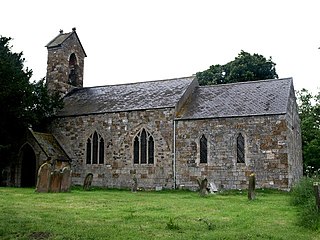
Fulstow is a marsh village and civil parish in the East Lindsey district of Lincolnshire, England. It is situated 6 miles (10 km) north of Louth and 8 miles (13 km) south of Grimsby.

Felicianova Manor is a Neo-Gothic manor house in Cibla Parish, Cibla Municipality in the historical region of Latgale, in Latvia.

Mexican-American folklore refers to the tales and history of Chicano people who live in the United States.













